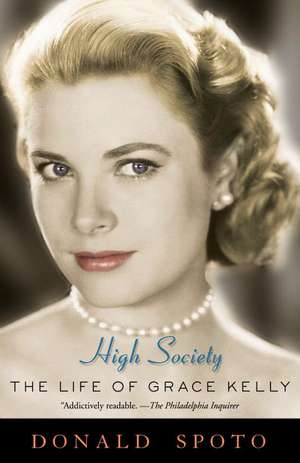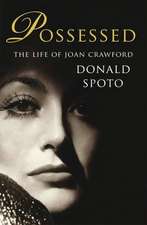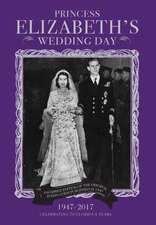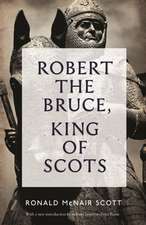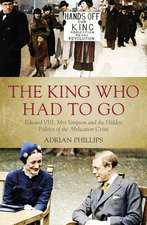High Society: The Life of Grace Kelly
Autor Donald Spotoen Limba Engleză Paperback – 30 sep 2010
In just seven years–from 1950 through 1956–Grace Kelly embarked on a whirlwind career that included roles in eleven movies. From the principled Amy Fowler Kane in High Noon to the thrill-seeking Frances Stevens of To Catch a Thief, Grace established herself as one of Hollywood’s most talented actresses and iconic beauties. Her astonishing career lasted until her retirement at age twenty-six, when she withdrew from stage and screen to marry a European monarch and became a modern, working princess and mother.
Based on never-before-published or quoted interviews with Grace and those conducted over many years with her friends and colleagues–from costars James Stewart and Cary Grant to director Alfred Hitchcock–as well as many documents disclosed by her children for the first time, acclaimed biographer Donald Spoto explores the transformation of a convent schoolgirl to New York model, successful television actress, Oscar-winning movie star, and beloved royal.
As the princess requested, Spoto waited twenty-five years after her death to write this biography. Now, with honesty and insight, High Society reveals the truth of Grace Kelly’s personal life, the men she loved, the men she didn’t, and what lay behind the façade of her fairy-tale life.
From the Hardcover edition.
Preț: 123.50 lei
Nou
Puncte Express: 185
Preț estimativ în valută:
23.63€ • 24.58$ • 19.51£
23.63€ • 24.58$ • 19.51£
Carte disponibilă
Livrare economică 25 martie-08 aprilie
Preluare comenzi: 021 569.72.76
Specificații
ISBN-13: 9780307395627
ISBN-10: 0307395626
Pagini: 320
Dimensiuni: 143 x 203 x 19 mm
Greutate: 0.27 kg
Editura: Three Rivers Press (CA)
ISBN-10: 0307395626
Pagini: 320
Dimensiuni: 143 x 203 x 19 mm
Greutate: 0.27 kg
Editura: Three Rivers Press (CA)
Notă biografică
DONALD SPOTO is the author of twenty-five books, including bestselling biographies of Alfred Hitchcock, Tennessee Williams, Laurence Olivier, Marlene Dietrich, Ingrid Bergman, and Audrey Hepburn. He earned his Ph.D. degree from Fordham University. Spoto is married to the Danish school administrator Ole Flemming Larsen; they live in a quiet village, an hour’s drive from Copenhagen.
From the Hardcover edition.
From the Hardcover edition.
Extras
One: Off the Main Line
I never really felt pretty, bright or socially adept.—Grace
In the late 1920s, the Hahnemann Medical College, at the corner of Broad and Vine Streets in Philadelphia, was one of the largest private hospitals in the United States. Unusual luxuries characterized the private rooms: a telephone and radio were installed at every bedside; nurses could be summoned and addressed by call-buttons and two-way speakers; and high-speed elevators whisked visitors to the wards. Although Hahnemann accepted emergency cases from every socioeconomic class, it catered, unofficially but famously, to the demands of the rich from the counties of eastern Pennsylvania.
Early in the morning of Tuesday, November 12, 1929, John B. Kelly escorted his wife, Margaret Majer Kelly, to Hahnemann, where, after an unexceptional labor, she bore her third child and second daughter. On December 1, the Kellys took the baby to St. Bridget’s Roman Catholic Church, a three-minute, half-mile drive from their home in the upscale neighborhood of Philadelphia known as East Falls. The infant was baptized Grace Patricia, in memory of an aunt who had died young, and (so Grace Kelly believed) “because I was Tuesday’s child”—who, according to Mother Goose, was “full of grace.”
On the banks of the Schuylkill River, East Falls has always been a quiet residential neighborhood, known for its easy commute to downtown Philadelphia. The most respected, established families—Protestants with “old money” like the Drexels, Biddles, Clarks, Cadwaladers and Wideners—lived across the river, in western suburbs along the ?so-?called Main Line, in eighteen communities (among them, Overbrook, Merion, Wynnewood, Ardmore, Haverford, Bryn Mawr, Rosemont and Radnor). The river was very like a social dividing line.
But membership in Philadelphia’s élite depended more on history than geography: one was “in society” only if a family could be traced back to colonial times, before the War of Independence. The class distinctions were so immutable that the Kellys knew they would never be accepted into high society, no matter the extent of their wealth. The Kellys were Irish, Roman Catholic and Democrats; Philadelphia society was English, Episcopalian and Republican. “We could have been members of the social register—the so-called Four Hundred—if we’d wanted to,” Grace Kelly’s mother said. “But we had other things to do.” If she really believed this, she was astonishingly naïve. Her husband knew otherwise; instead, he set out to “do well” in business, athletics and politics.
When Grace was born, the entire country was in the throes of a terrible financial crisis. At the end of October the stock market was in almost total collapse, signaling an economic disaster that led to the Great Depression. Scores of banks failed overnight; innumerable companies shut their doors forever; and millions of Americans were suddenly homeless and jobless, pitchforked into abject poverty and facing a future without prospects. The United States was steeped in despair, and newspapers chronicled a tragic epidemic of suicides.
Some families, however, were untouched by the gruesome facts of national life, and Grace’s was among them. Her father, John B. Kelly, had never speculated in the stock market, and his wealth—achieved in the construction trade during the boom time after the Great War—was held in cash and government bonds. His seventeen-room brick mansion at 3901 Henry Avenue was set amid lush, undulating lawns, and the property featured a tennis court and elaborate recreational equipment for active children. The house was mortgage-free, like Kelly’s seaside vacation home in Ocean City, New Jersey. The family sailed through the Depression enjoying a genteel, privileged life: the Kelly children attended private academies; there were household servants and workers to tend the grounds and gardens; and the children wore only the finest new seasonal wardrobes.
Grace had two older siblings: Margaret (“Peggy”), born in September 1925; and John junior (“Kell”), born in May 1927. The family was complete with the birth of Elizabeth Anne (“Lizanne”) in June 1933. “I wasn’t a strong child like my sisters and brother,” Grace said years later, “and my family told me they thought I was practically born with a cold—I was always sniffling and sneezing, clearing my throat and fighting some kind of respiratory ailment.” Her mother routinely reserved the juices of the family roasts for fragile young Grace, in a constant effort to improve the child’s strength and stamina.
“My other children were the strong ones, the extroverts, but Gracie was shy and retiring,” her mother recalled. “She was also frail and sickly a good deal of the time.” The girl filled the hours of her frequent confinements by making up stories and plays for her collection of dolls. “Grace could change her voice for each doll, giving it a different character. She loved attention for all this, but she didn’t cry if she didn’t get it.”
Thin and withdrawn, Grace preferred to read myths, fairy tales and books about dancers and dancing; indeed, her favorite dolls were fashioned like tiny ballerinas, complete with pointe shoes and delicate tutus. She also loved to read poetry and tried her hand at verses:
I hate to see the sun go downAnd squeeze itself into the ground,Since some warm night it might get stuckAnd in the morning not get up!
Grace was largely indifferent to physical activity: “I liked to swim, but did my best to avoid other sports and games.” This attitude made her something of an outsider. Her father had been an Olympic athlete, her mother a champion swimmer and physical education teacher, and their children were strongly encouraged—indeed, they were expected—to excel at competitive sports. Grace’s preference for books and imaginative games did not go down well with her father, a man who had little interest in cultural or intellectual matters.
Born in 1889, John B. “Jack” Kelly was the youngest of ten children born to Irish immigrants. Quitting school in early adolescence, he worked in the family firm as a bricklayer while perfecting his skill at sculling (rowing on the river), and during army service in the World War, he became a champion boxer. Returning to civilian life, Jack rejoined his father’s company, Kelly for Brickwork, and the postwar building boom of the 1920s quickly made him a millionaire. He did not, however, achieve this on his own, as he often implied, nor was he a self-made American success story. “They’ve latched on to the bricklayer theme and won’t let go of this Horatio Alger idea,” said his brother George, who directly confronted Jack’s self-glorification. “What’s all this talk about you getting callused hands laying bricks? The only times I remember you having calluses were from long hours of scull practice on the Schuylkill River!”
Wealth freed Jack to spend those long hours rowing. After winning six national championships, he headed for the Henley Regatta in England, the most celebrated event in the sport of sculling. But in 1920 his application for inclusion was rejected at the last minute when the judges determined that his years of manual labor and muscular development as a bricklayer gave him an unfair advantage over “gentleman” athletes. The true reason for his dismissal, however, was that the English authorities did not want to risk giving a prize to an Irish-American Catholic. The consequential outcry was so loud that by 1937 the rules at Henley no longer excluded manual laborers, mechanics or artisans as unfit for the competition.
More determined than ever after this rejection, Kelly proceeded to the 1920 summer Olympics at Antwerp, Belgium, where he won a gold medal in the single scull and, half an hour later, a second gold medal in the double scull, in which he rowed with a cousin. His family later swore to the truth of the anecdote that he mailed his racing cap to King George V with the message, “Greetings from a bricklayer.” Four years later, during the summer of 1924, Kelly and his cousin repeated their success at the Paris Olympics—an achievement that made “the Irish bricklayer” the first rower to win three Olympic gold medals. With that, he became one of the most famous athletes of his generation, and his name was included in the United States Olympic Hall of Fame. Later he was appointed National Physical Fitness Director by President Franklin D. Roosevelt, who regarded him as a good friend.
Before his Paris triumph, Kelly renounced bachelorhood (but not his avocation as a womanizer) when he married Margaret Majer on January 30, 1924, at St. Bridget’s Church. She was nine years his junior and as strikingly beautiful as he was darkly handsome. They had first met at a swim club, where she successfully competed; she was also one of Philadelphia’s most successful cover-girl models. With her degree in physical education, she became the first woman to teach that field at the University of Pennsylvania and at Women’s Medical College. She converted from Lutheranism to her fiancé’s religion just before their wedding.
“I had a good stiff German background,” Margaret said years later. “My parents believed in discipline and so do I—no tyranny or anything like that, but a certain firmness.” Proper appearances, unfailing decorum, the importance of manners: these were almost religious observances for Margaret Majer Kelly. She trained her children to control themselves, to hide pain and disappointment, to suppress their emotions in public, to disguise effort and to strive for perfection without seeming to do so. Her tutoring was more successful with Grace than with the others.
Margaret’s discipline was apparently unremitting. Kell nicknamed her “the Prussian general” for her heavy hand, and Grace recalled her mother’s insistence that her daughters learn not only the fine points of competitive sports but also those of sewing, cooking, dressmaking and gardening. “My mother was the disciplinarian in our family,” she said. “My father was very gentle, never the one to spank or scold. My mother did that. But when my father spoke—boy, you moved.” Life among the Kellys was to be enjoyed by the constant development of new skills and by the quiet assumption of responsibilities, and Margaret’s chief occupation became the training of her children. Jack, meanwhile, was involved in local politics, business, sports and a social (and amorous) life that excluded his family.
When Jack was at home, famous athletes from all over the world frequently visited. For the parents and for Peggy, Kell and Lizanne, these people were stimulating company; for Grace, they were tiresome and left her feeling more alienated than ever. “I never really felt pretty, bright or socially adept, and all that talk of sports, politics and business left me cold.” People often mistook Grace’s shyness for an attitude of superiority and, later, of snobbery. The truth was that, in addition to her quite different interests and hobbies, she was exceedingly nearsighted: without her hated glasses, very little was clear and she could not recognize people. “She was so myopic she couldn’t see ten feet in front of her” without glasses, recalled Howell Conant, who later became her favorite photographer.
Grace’s estimation of herself was also formed by her father’s favoritism, and this, as with any child, caused her some insecurity. “My older sister was my father’s favorite,” Grace reflected years later, “and then there was the boy, the only son. Then I came. After that, I had a baby sister, and I was terribly jealous of the attention she got. I was always on my mother’s knee, the clinging type. But I was pushed away [by my mother], and so I resented my sister for years.”
“Of the four children, Peggy was Jack’s favorite,” recalled Dorothea Sitley, a longtime family friend. “Grace was the introvert, the quiet, serene one, and she felt left out. It was always Peggy and her father together.” Jack admitted his preference for his firstborn child: “I thought it would be Peggy whose name would be up in lights one day. Anything that Grace could do, Peggy could always do better”—or so he thought.
“According to him, Peggy was destined to be the star of the family,” recalled Grace’s close friend and publicist, Rupert Allan (later also the Monégasque consul general in Los Angeles). “Jack never paid much attention to Grace—he accepted her, but he never understood her. But she adored him and always sought his approval.” Jack Kelly was “a very nice man,” recalled Grace’s friend Judith Balaban Kanter Quine, “but he was a man without much sensitivity.”
As much as she must have been aware of her father’s preference for Peggy, Grace longed for her older sister’s approval as much as for his. “I used to help my sister sell flowers to passersby to raise money for my mother’s pet charity, Women’s Medical College and Hospital of Pennsylvania. Naturally, most of our customers were the neighbors. Little did they know that some of the flowers came from their own gardens. I used to be sent by my big sister Peggy to raid the nearby gardens at night, and quite unashamedly we sold these same flowers back to their owners next morning.”
Just as she tried to befriend her sister, “Grace admired her father,” according to her close friend, the actress Rita Gam. “But she thought he really never appreciated her. He always preferred Peggy and never approved of Grace’s career—and her mother was a very tough lady, rather critical and not terribly warm. Both her parents said they were surprised and puzzled by Grace’s later success. When she talked about this, there was a certain wistfulness in her voice, but she was an extremely loyal person and very protective of her family.” What might be called Grace’s marginal status in a family of hardy, rah-rah competitors evoked a touching desire for demonstrative affection. “As a child,” recalled her sister Lizanne, “she loved to be held and cuddled and kissed.” This longing for physical tokens of affection increased with the years.
Grace and her father remained virtual strangers to each other until his death in 1960. She never addressed the topic directly, but she said that her father liked to be with rough, ?self-?confident children who could tumble on a playing field and bounce right back up. The implication was clear: that was not a description of Grace at any age, and she felt outside the orbit of his approval. Judy Quine agreed: “Jack Kelly ?didn’t cozy up to Grace. He understood business, politics and sports. He knew what these things were about, but he never ‘got it’ about Grace. Toward the end of his life, he accepted her. He saw her impact on the world and he showed her some respect. That’s what they shared at the end of his life—deep respect.”
It was perhaps inevitable, then, that a senior family servant named Godfrey Ford became something of a father figure. Addressed as “Fordie,” he was the Kelly chauffeur and factotum, evoking enormous affection from all the youngsters—and especially from Grace. “He kept their cars polished,” recalled the Kellys’ childhood friend Elaine Cruice Beyer. “He could serve, put on a big party, supervise bartenders and buffets and keep the gardens in beautiful condition.” Grace’s respect and fondness for the African-American Fordie instilled in her a lifelong hatred of racism.
On Thursdays, when the children's nanny was off duty, Fordie was entrusted with the task of putting the children to bed. "gracie asked my opinions about this and that," he recalled years later. "I'd tell her what I thought, and she'd usually follow my advice." later he gave her driving lessons in front of the house and in the long driveway, "but she was never good at parking."
From the Hardcover edition.
I never really felt pretty, bright or socially adept.—Grace
In the late 1920s, the Hahnemann Medical College, at the corner of Broad and Vine Streets in Philadelphia, was one of the largest private hospitals in the United States. Unusual luxuries characterized the private rooms: a telephone and radio were installed at every bedside; nurses could be summoned and addressed by call-buttons and two-way speakers; and high-speed elevators whisked visitors to the wards. Although Hahnemann accepted emergency cases from every socioeconomic class, it catered, unofficially but famously, to the demands of the rich from the counties of eastern Pennsylvania.
Early in the morning of Tuesday, November 12, 1929, John B. Kelly escorted his wife, Margaret Majer Kelly, to Hahnemann, where, after an unexceptional labor, she bore her third child and second daughter. On December 1, the Kellys took the baby to St. Bridget’s Roman Catholic Church, a three-minute, half-mile drive from their home in the upscale neighborhood of Philadelphia known as East Falls. The infant was baptized Grace Patricia, in memory of an aunt who had died young, and (so Grace Kelly believed) “because I was Tuesday’s child”—who, according to Mother Goose, was “full of grace.”
On the banks of the Schuylkill River, East Falls has always been a quiet residential neighborhood, known for its easy commute to downtown Philadelphia. The most respected, established families—Protestants with “old money” like the Drexels, Biddles, Clarks, Cadwaladers and Wideners—lived across the river, in western suburbs along the ?so-?called Main Line, in eighteen communities (among them, Overbrook, Merion, Wynnewood, Ardmore, Haverford, Bryn Mawr, Rosemont and Radnor). The river was very like a social dividing line.
But membership in Philadelphia’s élite depended more on history than geography: one was “in society” only if a family could be traced back to colonial times, before the War of Independence. The class distinctions were so immutable that the Kellys knew they would never be accepted into high society, no matter the extent of their wealth. The Kellys were Irish, Roman Catholic and Democrats; Philadelphia society was English, Episcopalian and Republican. “We could have been members of the social register—the so-called Four Hundred—if we’d wanted to,” Grace Kelly’s mother said. “But we had other things to do.” If she really believed this, she was astonishingly naïve. Her husband knew otherwise; instead, he set out to “do well” in business, athletics and politics.
When Grace was born, the entire country was in the throes of a terrible financial crisis. At the end of October the stock market was in almost total collapse, signaling an economic disaster that led to the Great Depression. Scores of banks failed overnight; innumerable companies shut their doors forever; and millions of Americans were suddenly homeless and jobless, pitchforked into abject poverty and facing a future without prospects. The United States was steeped in despair, and newspapers chronicled a tragic epidemic of suicides.
Some families, however, were untouched by the gruesome facts of national life, and Grace’s was among them. Her father, John B. Kelly, had never speculated in the stock market, and his wealth—achieved in the construction trade during the boom time after the Great War—was held in cash and government bonds. His seventeen-room brick mansion at 3901 Henry Avenue was set amid lush, undulating lawns, and the property featured a tennis court and elaborate recreational equipment for active children. The house was mortgage-free, like Kelly’s seaside vacation home in Ocean City, New Jersey. The family sailed through the Depression enjoying a genteel, privileged life: the Kelly children attended private academies; there were household servants and workers to tend the grounds and gardens; and the children wore only the finest new seasonal wardrobes.
Grace had two older siblings: Margaret (“Peggy”), born in September 1925; and John junior (“Kell”), born in May 1927. The family was complete with the birth of Elizabeth Anne (“Lizanne”) in June 1933. “I wasn’t a strong child like my sisters and brother,” Grace said years later, “and my family told me they thought I was practically born with a cold—I was always sniffling and sneezing, clearing my throat and fighting some kind of respiratory ailment.” Her mother routinely reserved the juices of the family roasts for fragile young Grace, in a constant effort to improve the child’s strength and stamina.
“My other children were the strong ones, the extroverts, but Gracie was shy and retiring,” her mother recalled. “She was also frail and sickly a good deal of the time.” The girl filled the hours of her frequent confinements by making up stories and plays for her collection of dolls. “Grace could change her voice for each doll, giving it a different character. She loved attention for all this, but she didn’t cry if she didn’t get it.”
Thin and withdrawn, Grace preferred to read myths, fairy tales and books about dancers and dancing; indeed, her favorite dolls were fashioned like tiny ballerinas, complete with pointe shoes and delicate tutus. She also loved to read poetry and tried her hand at verses:
I hate to see the sun go downAnd squeeze itself into the ground,Since some warm night it might get stuckAnd in the morning not get up!
Grace was largely indifferent to physical activity: “I liked to swim, but did my best to avoid other sports and games.” This attitude made her something of an outsider. Her father had been an Olympic athlete, her mother a champion swimmer and physical education teacher, and their children were strongly encouraged—indeed, they were expected—to excel at competitive sports. Grace’s preference for books and imaginative games did not go down well with her father, a man who had little interest in cultural or intellectual matters.
Born in 1889, John B. “Jack” Kelly was the youngest of ten children born to Irish immigrants. Quitting school in early adolescence, he worked in the family firm as a bricklayer while perfecting his skill at sculling (rowing on the river), and during army service in the World War, he became a champion boxer. Returning to civilian life, Jack rejoined his father’s company, Kelly for Brickwork, and the postwar building boom of the 1920s quickly made him a millionaire. He did not, however, achieve this on his own, as he often implied, nor was he a self-made American success story. “They’ve latched on to the bricklayer theme and won’t let go of this Horatio Alger idea,” said his brother George, who directly confronted Jack’s self-glorification. “What’s all this talk about you getting callused hands laying bricks? The only times I remember you having calluses were from long hours of scull practice on the Schuylkill River!”
Wealth freed Jack to spend those long hours rowing. After winning six national championships, he headed for the Henley Regatta in England, the most celebrated event in the sport of sculling. But in 1920 his application for inclusion was rejected at the last minute when the judges determined that his years of manual labor and muscular development as a bricklayer gave him an unfair advantage over “gentleman” athletes. The true reason for his dismissal, however, was that the English authorities did not want to risk giving a prize to an Irish-American Catholic. The consequential outcry was so loud that by 1937 the rules at Henley no longer excluded manual laborers, mechanics or artisans as unfit for the competition.
More determined than ever after this rejection, Kelly proceeded to the 1920 summer Olympics at Antwerp, Belgium, where he won a gold medal in the single scull and, half an hour later, a second gold medal in the double scull, in which he rowed with a cousin. His family later swore to the truth of the anecdote that he mailed his racing cap to King George V with the message, “Greetings from a bricklayer.” Four years later, during the summer of 1924, Kelly and his cousin repeated their success at the Paris Olympics—an achievement that made “the Irish bricklayer” the first rower to win three Olympic gold medals. With that, he became one of the most famous athletes of his generation, and his name was included in the United States Olympic Hall of Fame. Later he was appointed National Physical Fitness Director by President Franklin D. Roosevelt, who regarded him as a good friend.
Before his Paris triumph, Kelly renounced bachelorhood (but not his avocation as a womanizer) when he married Margaret Majer on January 30, 1924, at St. Bridget’s Church. She was nine years his junior and as strikingly beautiful as he was darkly handsome. They had first met at a swim club, where she successfully competed; she was also one of Philadelphia’s most successful cover-girl models. With her degree in physical education, she became the first woman to teach that field at the University of Pennsylvania and at Women’s Medical College. She converted from Lutheranism to her fiancé’s religion just before their wedding.
“I had a good stiff German background,” Margaret said years later. “My parents believed in discipline and so do I—no tyranny or anything like that, but a certain firmness.” Proper appearances, unfailing decorum, the importance of manners: these were almost religious observances for Margaret Majer Kelly. She trained her children to control themselves, to hide pain and disappointment, to suppress their emotions in public, to disguise effort and to strive for perfection without seeming to do so. Her tutoring was more successful with Grace than with the others.
Margaret’s discipline was apparently unremitting. Kell nicknamed her “the Prussian general” for her heavy hand, and Grace recalled her mother’s insistence that her daughters learn not only the fine points of competitive sports but also those of sewing, cooking, dressmaking and gardening. “My mother was the disciplinarian in our family,” she said. “My father was very gentle, never the one to spank or scold. My mother did that. But when my father spoke—boy, you moved.” Life among the Kellys was to be enjoyed by the constant development of new skills and by the quiet assumption of responsibilities, and Margaret’s chief occupation became the training of her children. Jack, meanwhile, was involved in local politics, business, sports and a social (and amorous) life that excluded his family.
When Jack was at home, famous athletes from all over the world frequently visited. For the parents and for Peggy, Kell and Lizanne, these people were stimulating company; for Grace, they were tiresome and left her feeling more alienated than ever. “I never really felt pretty, bright or socially adept, and all that talk of sports, politics and business left me cold.” People often mistook Grace’s shyness for an attitude of superiority and, later, of snobbery. The truth was that, in addition to her quite different interests and hobbies, she was exceedingly nearsighted: without her hated glasses, very little was clear and she could not recognize people. “She was so myopic she couldn’t see ten feet in front of her” without glasses, recalled Howell Conant, who later became her favorite photographer.
Grace’s estimation of herself was also formed by her father’s favoritism, and this, as with any child, caused her some insecurity. “My older sister was my father’s favorite,” Grace reflected years later, “and then there was the boy, the only son. Then I came. After that, I had a baby sister, and I was terribly jealous of the attention she got. I was always on my mother’s knee, the clinging type. But I was pushed away [by my mother], and so I resented my sister for years.”
“Of the four children, Peggy was Jack’s favorite,” recalled Dorothea Sitley, a longtime family friend. “Grace was the introvert, the quiet, serene one, and she felt left out. It was always Peggy and her father together.” Jack admitted his preference for his firstborn child: “I thought it would be Peggy whose name would be up in lights one day. Anything that Grace could do, Peggy could always do better”—or so he thought.
“According to him, Peggy was destined to be the star of the family,” recalled Grace’s close friend and publicist, Rupert Allan (later also the Monégasque consul general in Los Angeles). “Jack never paid much attention to Grace—he accepted her, but he never understood her. But she adored him and always sought his approval.” Jack Kelly was “a very nice man,” recalled Grace’s friend Judith Balaban Kanter Quine, “but he was a man without much sensitivity.”
As much as she must have been aware of her father’s preference for Peggy, Grace longed for her older sister’s approval as much as for his. “I used to help my sister sell flowers to passersby to raise money for my mother’s pet charity, Women’s Medical College and Hospital of Pennsylvania. Naturally, most of our customers were the neighbors. Little did they know that some of the flowers came from their own gardens. I used to be sent by my big sister Peggy to raid the nearby gardens at night, and quite unashamedly we sold these same flowers back to their owners next morning.”
Just as she tried to befriend her sister, “Grace admired her father,” according to her close friend, the actress Rita Gam. “But she thought he really never appreciated her. He always preferred Peggy and never approved of Grace’s career—and her mother was a very tough lady, rather critical and not terribly warm. Both her parents said they were surprised and puzzled by Grace’s later success. When she talked about this, there was a certain wistfulness in her voice, but she was an extremely loyal person and very protective of her family.” What might be called Grace’s marginal status in a family of hardy, rah-rah competitors evoked a touching desire for demonstrative affection. “As a child,” recalled her sister Lizanne, “she loved to be held and cuddled and kissed.” This longing for physical tokens of affection increased with the years.
Grace and her father remained virtual strangers to each other until his death in 1960. She never addressed the topic directly, but she said that her father liked to be with rough, ?self-?confident children who could tumble on a playing field and bounce right back up. The implication was clear: that was not a description of Grace at any age, and she felt outside the orbit of his approval. Judy Quine agreed: “Jack Kelly ?didn’t cozy up to Grace. He understood business, politics and sports. He knew what these things were about, but he never ‘got it’ about Grace. Toward the end of his life, he accepted her. He saw her impact on the world and he showed her some respect. That’s what they shared at the end of his life—deep respect.”
It was perhaps inevitable, then, that a senior family servant named Godfrey Ford became something of a father figure. Addressed as “Fordie,” he was the Kelly chauffeur and factotum, evoking enormous affection from all the youngsters—and especially from Grace. “He kept their cars polished,” recalled the Kellys’ childhood friend Elaine Cruice Beyer. “He could serve, put on a big party, supervise bartenders and buffets and keep the gardens in beautiful condition.” Grace’s respect and fondness for the African-American Fordie instilled in her a lifelong hatred of racism.
On Thursdays, when the children's nanny was off duty, Fordie was entrusted with the task of putting the children to bed. "gracie asked my opinions about this and that," he recalled years later. "I'd tell her what I thought, and she'd usually follow my advice." later he gave her driving lessons in front of the house and in the long driveway, "but she was never good at parking."
From the Hardcover edition.
Recenzii
“She was a great lady, and also great fun.”
—Ava Gardner
“She was anything but cold. Everything about Grace was appealing. She had those big warm eyes, and if you ever played a love scene with her, you knew she wasn’t cold.”
—James Stewart
“In two senses, she didn’t have a bad side–you could film her from any angle, and she was one of the most untemperamental, cooperative people in the business.”
—Cary Grant
“The subtlety of Grace’s sexuality–her elegant sexiness–appealed to me. . . . With Grace, you had to find it out–you had to discover it.”
—Alfred Hitchcock
“You couldn’t work with Grace Kelly without falling a little in love with her.”
—Fred Coe
“I thought she was the most gorgeous creature I ever met. . . . She was so entirely unaffected, completely without vanity.”
—Rita Gam
“She was a delight to have in the company–a rare kind of young person who had a hunger to learn and to improve herself.”
—Raymond Massey
“I saw the utter perfection of her nose . . . the long, elegant neck . . . the silky, diaphanous blond hair. . . . A very aristocratic-looking girl . . . not the sort you simply called for a date.”
—Oleg Cassini
From the Hardcover edition.
—Ava Gardner
“She was anything but cold. Everything about Grace was appealing. She had those big warm eyes, and if you ever played a love scene with her, you knew she wasn’t cold.”
—James Stewart
“In two senses, she didn’t have a bad side–you could film her from any angle, and she was one of the most untemperamental, cooperative people in the business.”
—Cary Grant
“The subtlety of Grace’s sexuality–her elegant sexiness–appealed to me. . . . With Grace, you had to find it out–you had to discover it.”
—Alfred Hitchcock
“You couldn’t work with Grace Kelly without falling a little in love with her.”
—Fred Coe
“I thought she was the most gorgeous creature I ever met. . . . She was so entirely unaffected, completely without vanity.”
—Rita Gam
“She was a delight to have in the company–a rare kind of young person who had a hunger to learn and to improve herself.”
—Raymond Massey
“I saw the utter perfection of her nose . . . the long, elegant neck . . . the silky, diaphanous blond hair. . . . A very aristocratic-looking girl . . . not the sort you simply called for a date.”
—Oleg Cassini
From the Hardcover edition.
Descriere
Drawing on his unprecedented access to Grace Kelly, bestselling biographer Spoto at last offers an intimate, honest, and authoritative portrait of one of Hollywood's legendary actresses.
